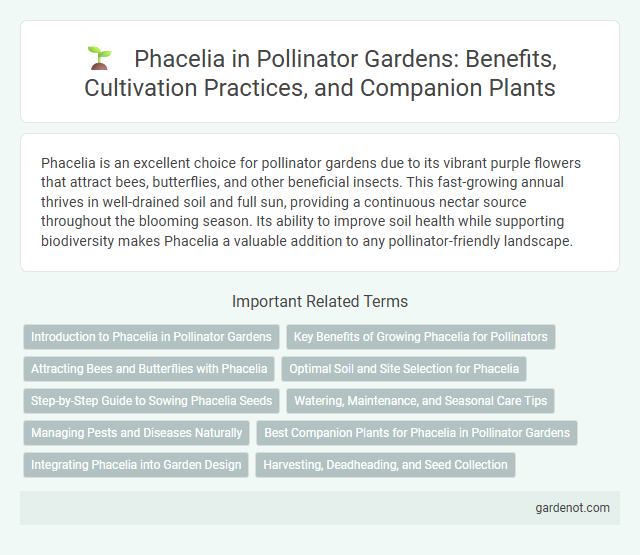Phacelia is an excellent choice for pollinator gardens due to its vibrant purple flowers that attract bees, butterflies, and other beneficial insects. This fast-growing annual thrives in well-drained soil and full sun, providing a continuous nectar source throughout the blooming season. Its ability to improve soil health while supporting biodiversity makes Phacelia a valuable addition to any pollinator-friendly landscape.
Introduction to Phacelia in Pollinator Gardens
Phacelia, a native wildflower, is highly valued in pollinator gardens for its abundant nectar and pollen sources that attract bees, butterflies, and other beneficial insects. Its fast-growing nature and vibrant blue to purple blossoms provide essential early-season forage, supporting pollinator populations when food resources are limited. Integrating Phacelia enhances biodiversity and promotes sustainable garden ecosystems by fostering healthy pollinator habitats.
Key Benefits of Growing Phacelia for Pollinators
Phacelia is a highly attractive plant for pollinators, providing abundant nectar and pollen that supports bees, butterflies, and other beneficial insects. Its rapid growth and dense flowering create an effective habitat, enhancing pollinator diversity and boosting local ecosystem health. Incorporating Phacelia into pollinator gardens increases forage availability during critical periods, promoting pollinator population resilience.
Attracting Bees and Butterflies with Phacelia
Phacelia is highly effective in attracting bees and butterflies due to its rich, nectar-filled flowers that bloom profusely throughout the growing season. The plant's vibrant purple blooms serve as a magnet for various pollinators, including honeybees, bumblebees, and swallowtail butterflies. Incorporating Phacelia into a pollinator garden enhances biodiversity and supports healthy pollination ecosystems.
Optimal Soil and Site Selection for Phacelia
Phacelia thrives best in well-drained, sandy loam soils enriched with organic matter, promoting healthy root development and vigorous flowering. Selecting a site with full sun exposure for at least six hours daily enhances nectar production, attracting a diverse range of pollinators such as bees and butterflies. Avoiding heavy clay soils and areas with poor drainage prevents root rot and supports sustainable growth for optimal pollinator garden performance.
Step-by-Step Guide to Sowing Phacelia Seeds
Sow Phacelia seeds directly in well-drained soil during early spring or late summer for optimal germination. Scatter seeds thinly on the surface and lightly press them into the soil without covering, as they require light for sprouting. Maintain consistent moisture and thin seedlings to about 6-12 inches apart to encourage healthy growth and abundant blooms that attract pollinators.
Watering, Maintenance, and Seasonal Care Tips
Phacelia thrives in well-drained soil with moderate watering, avoiding waterlogging to prevent root rot. Regular deadheading encourages continuous blooming and supports pollinator activity throughout the growing season. Seasonal care includes mulching in early spring to retain moisture and protect roots during colder months, ensuring robust growth and sustained floral displays.
Managing Pests and Diseases Naturally
Phacelia attracts beneficial insects that help control common garden pests such as aphids and spider mites without chemical intervention. Cultivating Phacelia enhances biodiversity by supporting predatory insects like ladybugs and lacewings, which naturally reduce pest populations. Maintaining healthy soil and avoiding excessive fertilization also helps prevent fungal diseases commonly affecting Phacelia plants.
Best Companion Plants for Phacelia in Pollinator Gardens
Phacelia thrives alongside companion plants such as sunflowers, lavender, and coneflowers, which attract a diverse range of pollinators including bees, butterflies, and hummingbirds. Combining Phacelia with native wildflowers like black-eyed Susan and bee balm enhances pollinator activity by providing continuous blooms throughout the growing season. These companion plants improve soil health and increase biodiversity, creating an optimal environment for pollinators in garden ecosystems.
Integrating Phacelia into Garden Design
Phacelia enhances pollinator gardens by attracting bees, butterflies, and other beneficial insects with its vibrant lavender-blue flowers and high nectar production. Incorporate Phacelia as a ground cover or border plant to improve soil health through nitrogen fixation while supporting biodiversity. Its fast growth and compatibility with companion plants make it ideal for filling gaps and creating layered, pollinator-friendly landscapes.
Harvesting, Deadheading, and Seed Collection
Phacelia thrives in pollinator gardens with regular deadheading to encourage continuous blooming and prevent premature seed drop. Harvesting Phacelia seeds involves collecting mature seed heads once they turn dry and brown, typically 3-4 weeks after flowering. Storing seeds in a cool, dry place ensures viability for future planting, supporting sustainable garden cycles and pollinator habitats.
Phacelia Infographic

 gardenot.com
gardenot.com